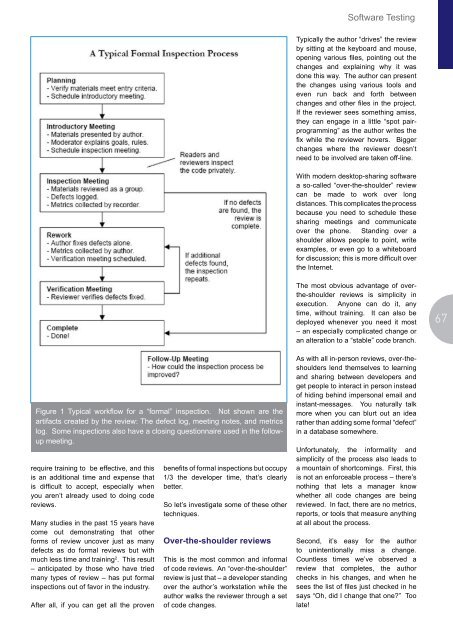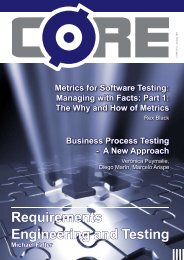Comparison of Change Management Systems
Comparison of Change Management Systems
Comparison of Change Management Systems
You also want an ePaper? Increase the reach of your titles
YUMPU automatically turns print PDFs into web optimized ePapers that Google loves.
Figure 1 Typical workflow for a “formal” inspection. Not shown are the<br />
artifacts created by the review: The defect log, meeting notes, and metrics<br />
log. Some inspections also have a closing questionnaire used in the followup<br />
meeting.<br />
require training to be effective, and this<br />
is an additional time and expense that<br />
is difficult to accept, especially when<br />
you aren’t already used to doing code<br />
reviews.<br />
Many studies in the past 15 years have<br />
come out demonstrating that other<br />
forms <strong>of</strong> review uncover just as many<br />
defects as do formal reviews but with<br />
much less time and training 2 . This result<br />
– anticipated by those who have tried<br />
many types <strong>of</strong> review – has put formal<br />
inspections out <strong>of</strong> favor in the industry.<br />
After all, if you can get all the proven<br />
benefits <strong>of</strong> formal inspections but occupy<br />
1/3 the developer time, that’s clearly<br />
better.<br />
So let’s investigate some <strong>of</strong> these other<br />
techniques.<br />
Over-the-shoulder reviews<br />
This is the most common and informal<br />
<strong>of</strong> code reviews. An “over-the-shoulder”<br />
review is just that – a developer standing<br />
over the author’s workstation while the<br />
author walks the reviewer through a set<br />
<strong>of</strong> code changes.<br />
S<strong>of</strong>tware Testing<br />
Typically the author “drives” the review<br />
by sitting at the keyboard and mouse,<br />
opening various files, pointing out the<br />
changes and explaining why it was<br />
done this way. The author can present<br />
the changes using various tools and<br />
even run back and forth between<br />
changes and other files in the project.<br />
If the reviewer sees something amiss,<br />
they can engage in a little “spot pairprogramming”<br />
as the author writes the<br />
fix while the reviewer hovers. Bigger<br />
changes where the reviewer doesn’t<br />
need to be involved are taken <strong>of</strong>f-line.<br />
With modern desktop-sharing s<strong>of</strong>tware<br />
a so-called “over-the-shoulder” review<br />
can be made to work over long<br />
distances. This complicates the process<br />
because you need to schedule these<br />
sharing meetings and communicate<br />
over the phone. Standing over a<br />
shoulder allows people to point, write<br />
examples, or even go to a whiteboard<br />
for discussion; this is more difficult over<br />
the Internet.<br />
The most obvious advantage <strong>of</strong> overthe-shoulder<br />
reviews is simplicity in<br />
execution. Anyone can do it, any<br />
time, without training. It can also be<br />
deployed whenever you need it most<br />
– an especially complicated change or<br />
an alteration to a “stable” code branch.<br />
As with all in-person reviews, over-theshoulders<br />
lend themselves to learning<br />
and sharing between developers and<br />
get people to interact in person instead<br />
<strong>of</strong> hiding behind impersonal email and<br />
instant-messages. You naturally talk<br />
more when you can blurt out an idea<br />
rather than adding some formal “defect”<br />
in a database somewhere.<br />
Unfortunately, the informality and<br />
simplicity <strong>of</strong> the process also leads to<br />
a mountain <strong>of</strong> shortcomings. First, this<br />
is not an enforceable process – there’s<br />
nothing that lets a manager know<br />
whether all code changes are being<br />
reviewed. In fact, there are no metrics,<br />
reports, or tools that measure anything<br />
at all about the process.<br />
Second, it’s easy for the author<br />
to unintentionally miss a change.<br />
Countless times we’ve observed a<br />
review that completes, the author<br />
checks in his changes, and when he<br />
sees the list <strong>of</strong> files just checked in he<br />
says “Oh, did I change that one?” Too<br />
late!<br />
67



